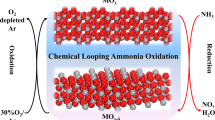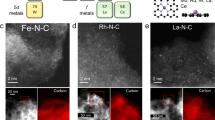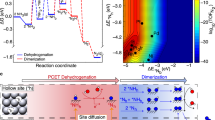Abstract
THE oxidation of ammonia on platinum metals has been the subject of considerable experimental study since long before the first commercial application of the process more than 60 yr ago, yet the detailed mechanism of the oxidation reaction still remains the subject of discussion and unresolved controversy. Various theories for the mechanism have been put forward1,2, involving various stable and unstable species (for example, NH2OH, NH, UNO, HNO2, N2O as well as NO and H2O) as intermediate products in simultaneous or consecutive reactions on or near the surface of the catalyst.
This is a preview of subscription content, access via your institution
Access options
Subscribe to this journal
Receive 51 print issues and online access
$199.00 per year
only $3.90 per issue
Buy this article
- Purchase on SpringerLink
- Instant access to full article PDF
Prices may be subject to local taxes which are calculated during checkout
Similar content being viewed by others
References
Zawadski, J., Disc. Faraday Soc., 8, 140 (1950).
Molinari, E., J. Catal., 4, 341 (1965).
Nutt, C. W., and Carter, A. J., Trans. Faraday Soc., 64, 771 (1968).
Author information
Authors and Affiliations
Rights and permissions
About this article
Cite this article
NUTT, C., KAPUR, S. Mechanism of Oxidation of Ammonia on Platinum. Nature 220, 697–698 (1968). https://doi.org/10.1038/220697a0
Received:
Issue date:
DOI: https://doi.org/10.1038/220697a0
This article is cited by
-
The preparation, properties and reactions of diimide
Reviews of Chemical Intermediates (1984)
-
Energy dissipation and selectivity in the catalytic oxidation of ammonia
Reaction Kinetics and Catalysis Letters (1979)
-
Oxidation of Ammonia on Platinum
Nature (1969)



